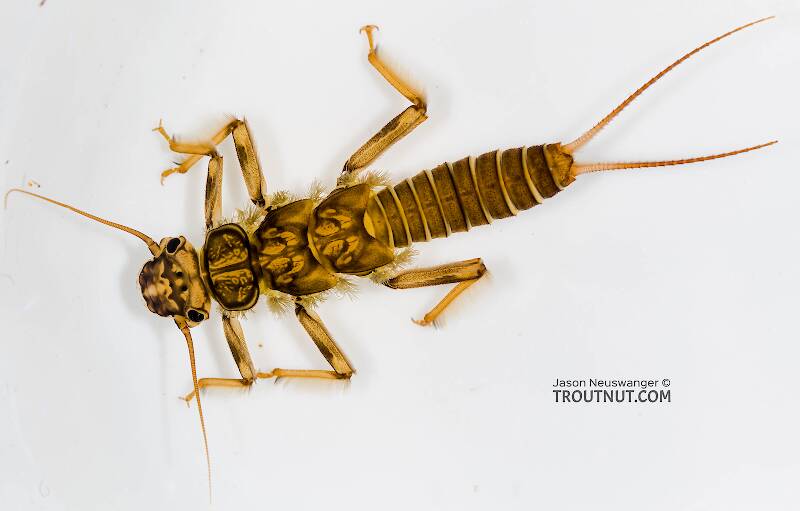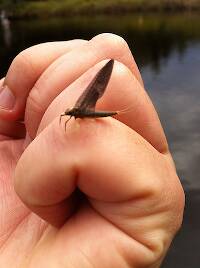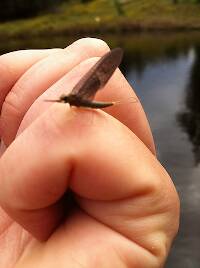
Hex Mayflies
Hexagenia limbata
The famous nocturnal Hex hatch of the Midwest (and a few other lucky locations) stirs to the surface mythically large brown trout that only touch streamers for the rest of the year.
Featured on the forum

Troutnut is a project started in 2003 by salmonid ecologist Jason "Troutnut" Neuswanger to help anglers and
fly tyers unabashedly embrace the entomological side of the sport. Learn more about Troutnut or
support the project for an enhanced experience here.
Ozzie
Posts: 2
Posts: 2
Ozzie on Jul 15, 2008July 15th, 2008, 3:30 pm EDT
Anyone have a good example of what I've heard referred to as a Quigley's Cripple? Supposed to imitate a Brown Drake cripple. Any help would be much appreciated!!
Ozzie
Ozzie
Taxon on Jul 15, 2008July 15th, 2008, 8:10 pm EDT
GONZO on Jul 16, 2008July 16th, 2008, 4:21 pm EDT
Ozzie,
To compliment the photo that Roger provided, here's a link that includes tying instructions for the Quigley Cripple style:
http://www.flyfisherman.com/ftb/quigleycripple/index.html
As for Roger's generous comment about my patterns, I do have some that imitate Brown Drake nymphs, emergers, duns, and spinners. But I wouldn't say that they are better, just a bit more accurate (perhaps) and a bit more complicated to tie. I would recommend starting with the Quigley style or even something a little simpler. I have always advocated using the simplest fly that will work in a given situation. You can always make it more elaborate, but if the simpler tie works, there's no need to get fancy (unless you just enjoy it).
Speaking of "cripples," I'll share something that a friend told me recently. He was discussing fly patterns with another Pocono fisherman (in a bar, I believe) when the fellow commented that he was surprised that I didn't design any "cripple" patterns. When I told my friend that I tie lots of emergers and asked him what the difference was, he shrugged his shoulders and said "Exactly!" with a wry smile. I suppose one could say that an emerger pattern represents an emerging insect and a cripple represents those that will not emerge successfully, but it begs the question of how the trout could possibly know the difference. I guess my emergers just look too healthy! :)
To compliment the photo that Roger provided, here's a link that includes tying instructions for the Quigley Cripple style:
http://www.flyfisherman.com/ftb/quigleycripple/index.html
As for Roger's generous comment about my patterns, I do have some that imitate Brown Drake nymphs, emergers, duns, and spinners. But I wouldn't say that they are better, just a bit more accurate (perhaps) and a bit more complicated to tie. I would recommend starting with the Quigley style or even something a little simpler. I have always advocated using the simplest fly that will work in a given situation. You can always make it more elaborate, but if the simpler tie works, there's no need to get fancy (unless you just enjoy it).
Speaking of "cripples," I'll share something that a friend told me recently. He was discussing fly patterns with another Pocono fisherman (in a bar, I believe) when the fellow commented that he was surprised that I didn't design any "cripple" patterns. When I told my friend that I tie lots of emergers and asked him what the difference was, he shrugged his shoulders and said "Exactly!" with a wry smile. I suppose one could say that an emerger pattern represents an emerging insect and a cripple represents those that will not emerge successfully, but it begs the question of how the trout could possibly know the difference. I guess my emergers just look too healthy! :)
Ozzie
Posts: 2
Posts: 2
Ozzie on Jul 16, 2008July 16th, 2008, 5:04 pm EDT
Gentlemen,
Thank you for the examples and thoughts. You are both very experienced and I thank you for sharing the information. The cripple seems to present an advantage over the emerger, in the fact that it is "stuck" and relatively helpless. As long as the fish prefer them - I don't care what they are termed. I'll try the pattern as suggested - keeping it simple. Most appreciated!
Thanks again,
Ozzie
Thank you for the examples and thoughts. You are both very experienced and I thank you for sharing the information. The cripple seems to present an advantage over the emerger, in the fact that it is "stuck" and relatively helpless. As long as the fish prefer them - I don't care what they are termed. I'll try the pattern as suggested - keeping it simple. Most appreciated!
Thanks again,
Ozzie
Quick Reply
Related Discussions
Topic
Replies
Last Reply






